TITLE: Planting 10 acres of woodland
DATE: 2021-03-25
AUTHOR: John L. Godlee
====================================================================
This post describes the process I went through with the Woodland
Trust MOREWoods tree planting scheme, to plant 10 acres (4.05
hectares) on some farmland in North Yorkshire.
[Woodland Trust MOREWoods]:
https://www.woodlandtrust.org.uk/plant-trees/large-scale-planting/mo
rewoods/
I found historical maps through the University of Edinburgh Digimap
service which showed that some of the pasture on our farm had
previously been woodland. The images below show what the woodland
looked like in 1892, 1919, 1957, and 2018. Clearly at some point
between 1919 and 1957 a large portion of the woodland was felled.
This is the area I aimed to re-plant. Since at least 1957, the land
has only been used as rough pasture for sheep and cattle.
[University of Edinburgh Digimap]: https://digimap.edina.ac.uk/
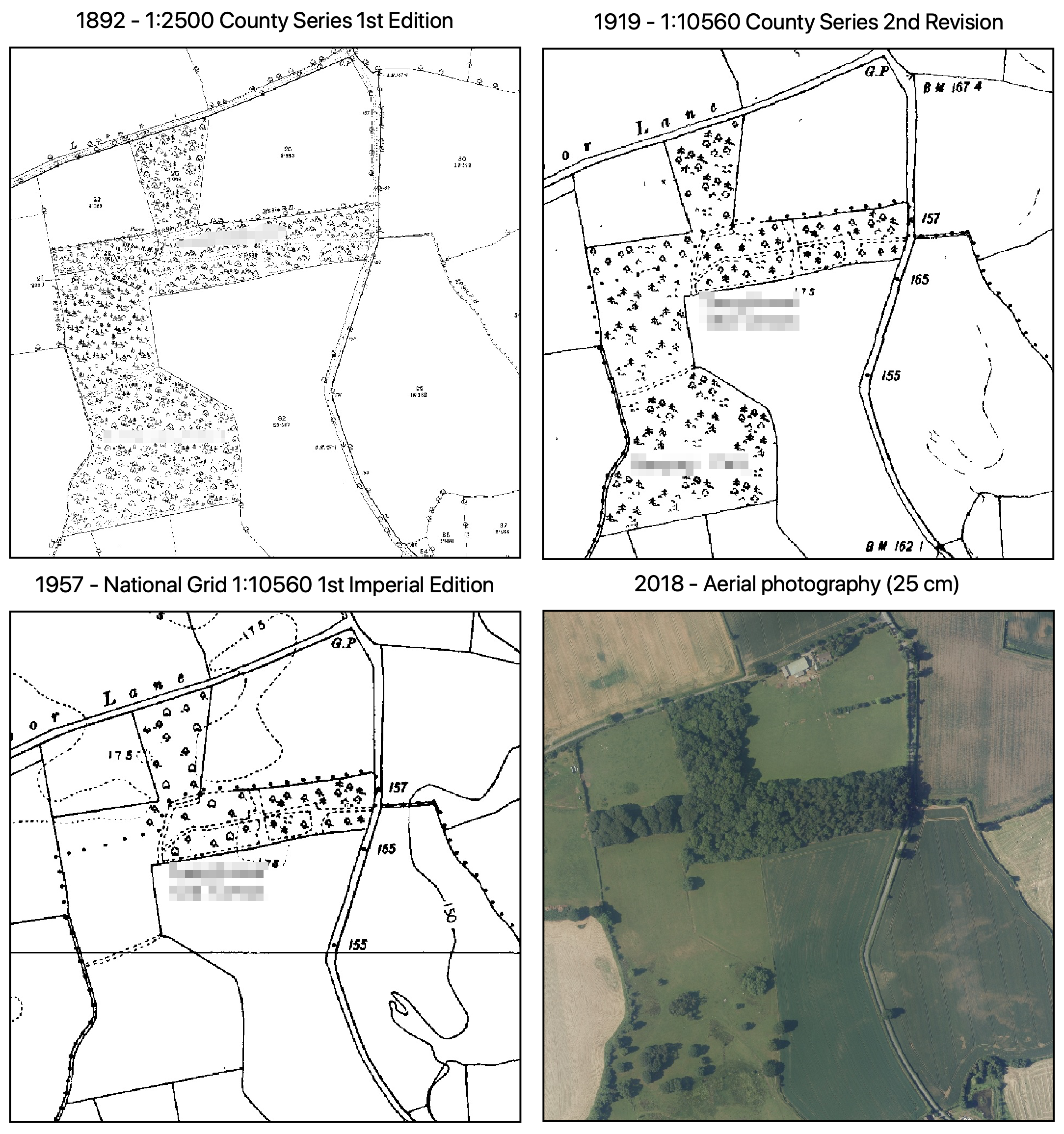
In addition to previously being woodland, the other main reason I
wanted to plant this area was to increase the size of the existing
woodland. Some plant and bird species require the darkness and
humidity of a deep woodland interior to thrive, which they weren't
getting in the current woodland. Finally, I wanted to make better
use of the land than rough pasture. The soil is relatively thin,
with a well-drained gravel pan only about 30-50 cm below the
surface. The grass has never been particularly productive and
contains a lot of moss, probably a result of over-grazing.
Although I started to think seriously about woodland planting in
summer 2018, we didn't officially lodge our application with the
MOREWoods scheme until May 2019. We looked around a few schemes
which provide subsidies for tree planting. Some of the larger
grants weren't suitable for us because of complications caused by
renting the land out to a tenant farmer at the time of application.
MOREWoods was a good option for me because I am a novice at land
management and the grant provides guidance from a qualified
consultant who can help with planning what species to plant, where
to plant them, and how to manage the trees after planting. The
initial application was fairly easy. We had to provide a map of the
area to be planted, and confirm things about land tenure and
current land usage. MOREWoods agreed to pay for 80% of the cost of
trees and guards because we are within the Woodland Trust's
Northern Forest region.
[Northern Forest]:
https://www.woodlandtrust.org.uk/about-us/what-we-do/we-plant-trees/
the-northern-forest/
After we passed the initial Woodland Trust (WT) screening process
we started to look at how we would take the land back from the farm
tenancy. For many years the pasture and arable fields on the farm
have been rented out to tenant farmers. Farm tenancies have much
longer notice periods than houses, we had to give a notice period
of almost a full year to take back the land, and the handover had
to happen on the 1st January, to fit with the farming calendar and
the subsidy payment schedule. Also, according to the tenancy, we
were only allowed to reclaim up to 10 acres per year, unless we
gave notice for the entire farm, which entails its own difficulties.
The farm tenants were quite worried about correctly marking the
fencing line which would divide the field so we could plant one
part of it. Apparently the farming subsidies can be quite strict
about misrepresenting field sizes, and often impose penalties if a
field has been measured incorrectly. To mark the field I used QGIS
to draw an area of exactly 10 acres, using an OS 1:2500 map as a
guide for the field boundaries. I tried initially to use satellite
imagery, but because of the overhang of hedges and trees I found it
difficult to accurately determine the boundaries of the field. I
measured the distance from known points along the existing fence
lines to determine the new fence line. On-site we used a trundle
wheel to measure those distances and marked the new fence line at
both ends with iron rods driven deep into the ground. In
hind-sight, we should have used a tape measure rather than a
trundle wheel, because the uneven ground messed up the distance
measures a bit, but eventually we came to a fence line that
everybody agreed on.
[QGIS]: https://www.qgis.org/en/site/
[OS 1:2500 map]:
https://www.gov.uk/government/publications/land-registry-plans-the-b
asis-of-land-registry-applications/land-registry-plans-the-basis-of-
land-registry-plans-practice-guide-40-supplement-1
[trundle wheel]: https://en.wikipedia.org/wiki/Trundle_wheel
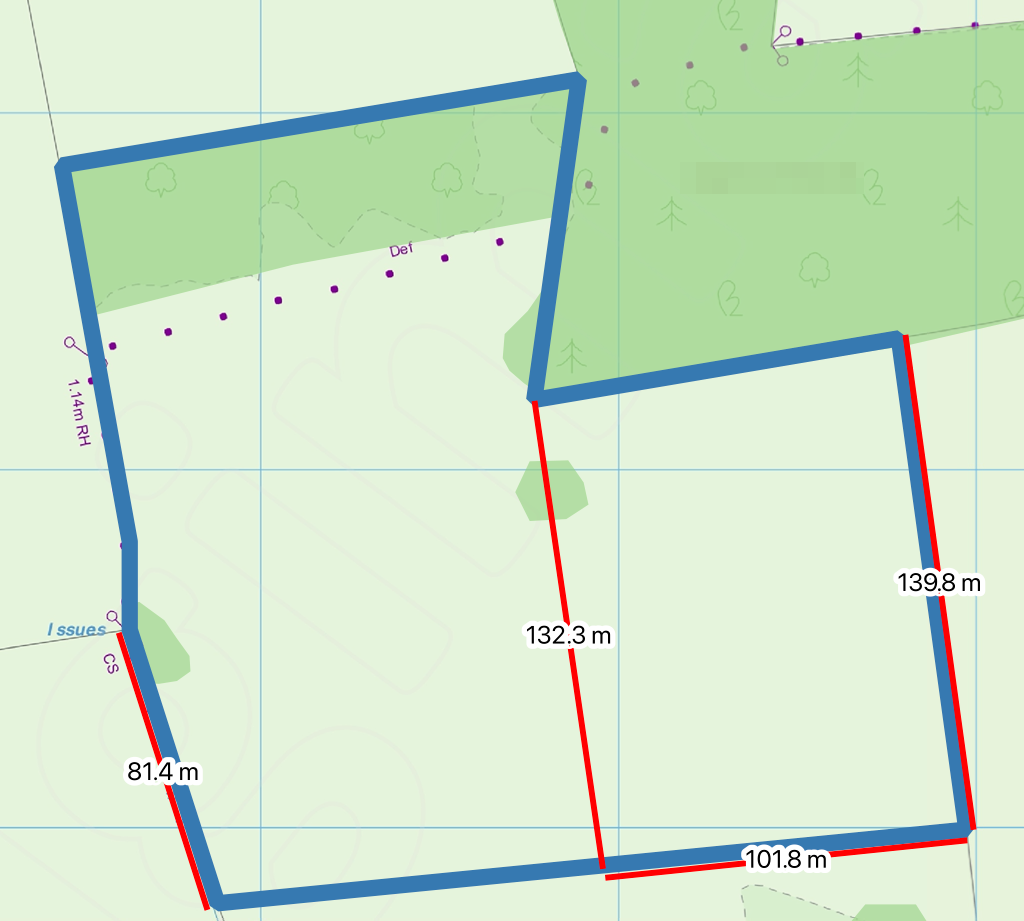

Unfortunately even though the Woodland Trust approved our
application in August 2019, it took until April 2020 to organise a
consultant to survey the land and discuss species mixes. Then after
we sent off the report based on the consultation, it took the WT
until August 2020 to realise that they actually needed an
Environmental Impact Assessment (EIA) from the Forestry Commission,
because the new woodland is >3 ha. The process for the EIA was
slow. We had to consult "local stakeholders" via the Parish
Council, adjacent land-owners, and also the local authority
archaeology department. The archaeology people had an issue with a
small part of the planting site which appeared from a satellite
image to have an old ridge-and-furrow (rigg and furr) system. We
were skeptical of this assessment, especially as they hadn't
conducted an on-site survey, but to avoid further delay we complied
with their wishes and left part of the planting area as open
ground. After gathering all these consultations the EIA took until
December 2020 to be approved, then until mid-January 2021 to
actually sign the contract from the WT. I think the WT offices had
difficulty processing applications because of COVID restrictions
which meant their staff were sometimes working from home. On the
whole however, I was disappointed with the service from the WT. It
seemed like a lot of stress could have been avoided if the WT had
pushed the process along a bit quicker, rather than waiting for
months between each stage. I was also disturbed that although our
application was described "approved" in 2019, it clearly wasn't and
there were many more hoops we had to jump through before there was
truly no going back. It would have been very annoying if we had
taken back the land from the farm tenancy only to later find out
that the MOREWoods grant wouldn't pay out.
[Environmental Impact Assessment]:
https://www.gov.uk/guidance/environmental-impact-assessments-for-woo
dland-overview
[ridge-and-furrow]: https://en.wikipedia.org/wiki/Ridge_and_furrow
I was given a lot of control over the species mix of the new
woodland. I opted for two main zones (compartments). The larger
compartment is dominated by pedunculate oak (Quercus robur) and
Hornbeam (Carpinus betulus), both large canopy trees with long
lifespans and which provide decent hardwood for building and
firewood. The smaller compartment is dominated by silver birch
(Betula pendula) and hazel (Coryllus avellana), shorter lived
species which coppice well and can provide us with smaller poles
and canes, which are useful for making hurdles, or for smaller
firewood. We weren't allowed to plant ash (Fraxinus excelsior)
because of the likelihood of it succumbing to ash dieback, though
there is a lot in the existing adjacent woodland. In addition to
the principal species, we also included shrubs and other species at
lower percentages scattered throughout the compartments, simply to
increase biodiversity and to have a bit of variety.
Below is the full breakdown of species and which compartment they
go in:
Compartment Alder Blackthorn Birch Alder
buckthorn Hazel Hawthorn Hornbeam Holly Wild cherry Oak
TOTAL
------------------------ ------- ------------ -------
----------------- ------- ---------- ---------- -------
------------- ----- -------
Short Rotation Coppice 0 0 300 0
400 0 0 75 0 50 825
Long Rotation Coppice 0 150 500 75
350 0 950 75 350 900 3350
Edge Shelter Belt 0 100 150 25
100 75 0 50 0 0 500
Alder Carr 50 0 0 0
0 0 0 0 0 0 50
---------------------- ----- ---------- -----
--------------- ----- -------- -------- ----- -----------
--- -----
TOTAL 50 250 950 100
850 75 950 200 350 950 4725
To generate these numbers I started off by calculating how many
trees would fit in each compartment based on the compartment area
and the 2.5 m distance between each tree. Then for each species in
each compartment, I decided what percentage of the trees I would
like from each species in each compartment. Then I divided the
total number of trees by the percentage to get the number of trees
per species. Because the trees come in bundles of 25, I then had to
round up or down to the nearest 25.
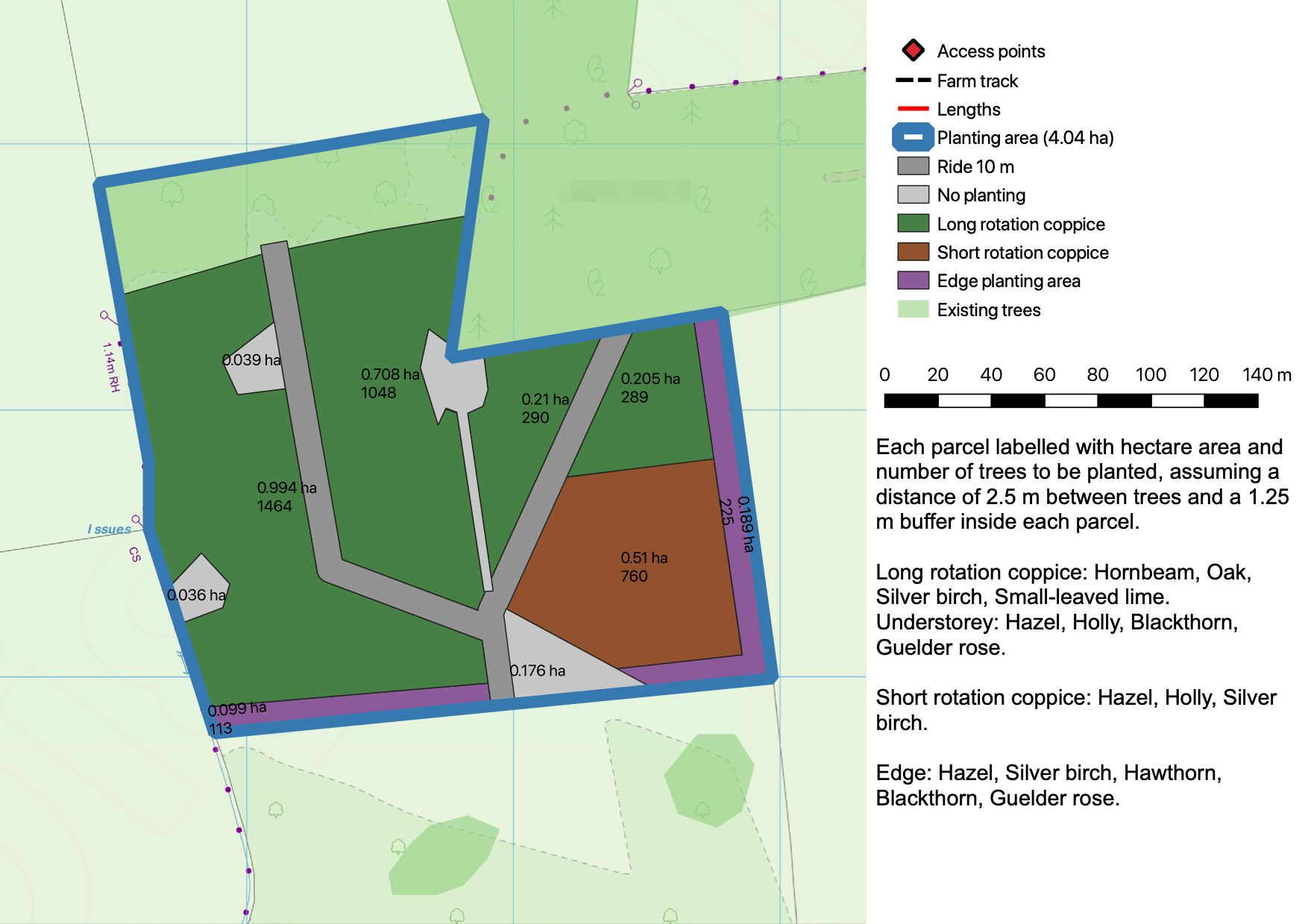
The alder area is located in a patch which gets flooded seasonally.
Alder (Alnus glutinosa) can deal very well with wet conditions, so
I thought it would be the best species for that area. We left a bit
of a marshy pond bit in the middle which can act as a habitat as
the woodland grows. We left a couple of open glades in the woodland
in the hope that these will also increase biodiversity by providing
open but sheltered areas, popular with butterflies and bees.
The edge belt is there primarily to provide some shelter at the
edge of the woodland, so that the wind doesn't blast through the
understorey. Planting a shelter belt can drastically alter the
micro-climate in the understorey, hopefully providing a warmer and
wetter environment that is more suitable for insects, small
mammals, and wildflowers. It also means there is more of a natural
barrier should any livestock eventually break through a fence.
Finally there is a wedge-shaped patch at the southern end of the
site near the gate which we have left empty so that we can use it
for other things. Helpfully this patch coincides with most of the
area the archaeology people wanted to leave un-planted. I'm hoping
to install some bays that we can use to process and keep wood in
before it is transported nearer the house for drying. Also I'd like
to have a bay for wood-chippings, which we are going to use as
mulch around the base of the trees to keep weeds down.
By the time we got to mid-December 2020 it was clear that having
volunteer groups in to plant the trees, as had been the original
plan, was untenable because of COVID restrictions that meant we
couldn't safely house or feed the volunteers if they needed to stay
overnight. Instead we opted to use a professional tree-planting
company who are based nearby and who came recommended by a family
friend. The tree-planting company cost a lot of money, but under
the circumstances it was the only safe option. I still feel guilty
for not involving the community more, but circumstance forced my
hand.
Our trees were delivered on pallets by a lorry with a forklift on
the back. We loaded as much as possible onto a trailer, and
transported it in batches over to the planting site. Most of the
volume of the delivery consisted of tree guards and stakes. The
4725 trees all fitted onto one large pallet. The trees arrived bare
rooted in plastic bags, which meant they had to be planted ideally
within about 7-10 days.

The tree-planting company marked out the different compartments of
the planting site with bamboo canes with flagging tape attached. I
helped with this process because there were a few adjustments and
judgement calls to be made since the gate holes and therefore the
10 m wide track had changed position from when I made the planting
map. The tree planting company used an Android mapping app with an
overlay of the planting area I had sent them to mark out the
different areas. I thought this worked well, but I felt that they
relied on it a bit too much and I had to pull them back a couple of
times on common sense issues. See the image below where some trees
have been planted under an overhanging hedge tree, which is
probably not the best idea.


I helped with some of the planting, and learned a lot about how to
find the rhythm when planting many hundreds of trees, but mostly I
left the professionals to it and just checked in every day to see
if they had questions or problems. They planted in rows to allow
easy access for mowers, but offset each row so that from most
angles the trees appear more naturally distributed. I thought this
was very effective at breaking the visual lines. See the photo
below. Mostly the tree planters didn't use any special equipment,
only tree-planting spades, hammers, and bamboo canes, but one
incredibly useful addition to their arsenal was a John Deere Gator
Utility Vehicle, which looks a bit like an off-road golf cart. It
allowed them to quickly move stuff around the site without churning
up the wet ground. If they had relied on wheelbarrows instead it
would have taken much longer to get set up.
[John Deere Gator Utility Vehicle]:
https://www.deere.co.uk/en/gator-utility-vehicles/
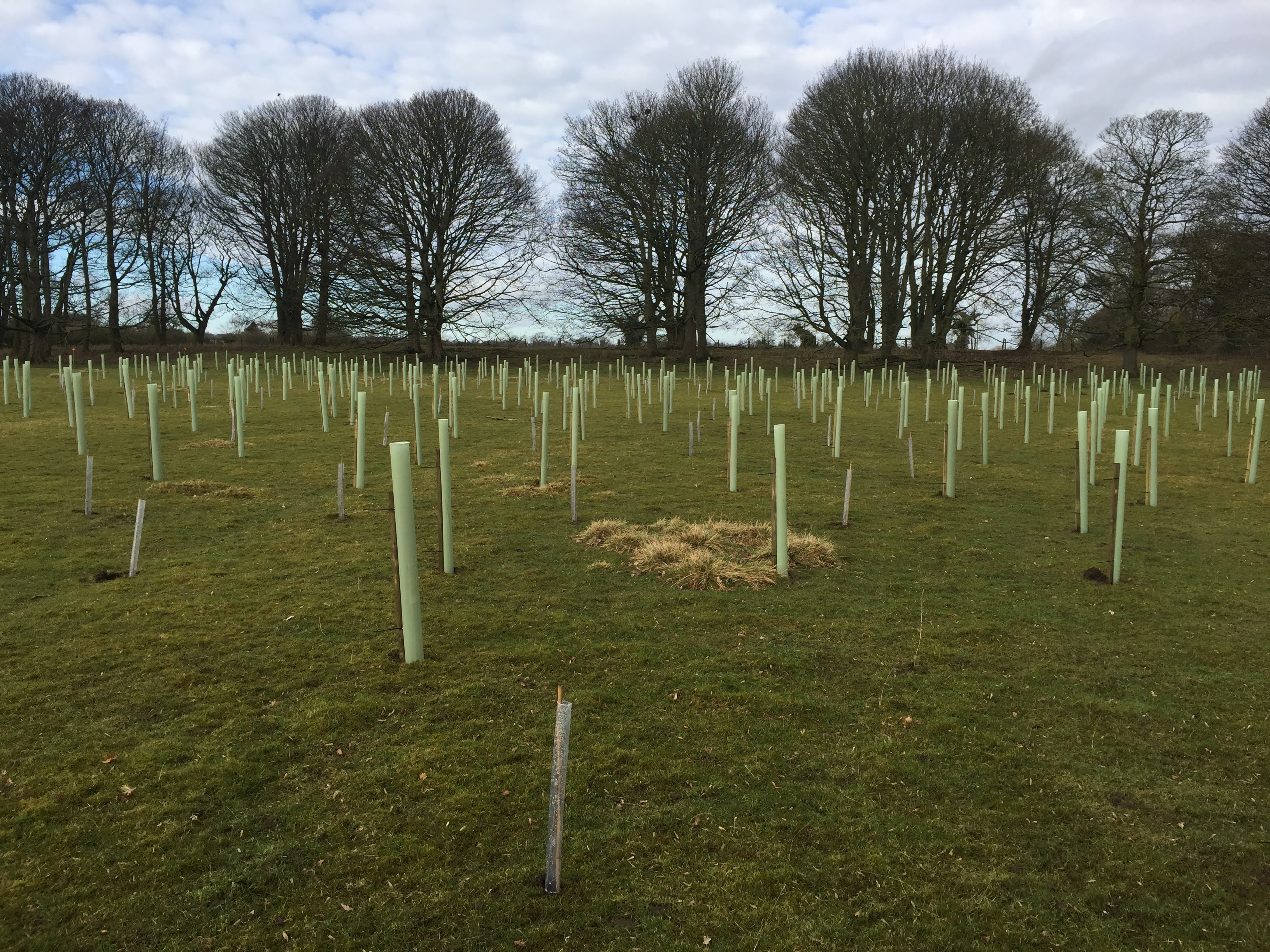
After the tree planters had left, we did a few checks to make sure
everything was in order. We walked through each tree and looked for:
- Trees without guards
- Guards with too few zip-ties
- Trees with bent over main stems
- Trees where the main stem or a substantial branch was threaded
through the zip-tie
Fixing all these small issues, while tedious, is definitely worth
it, as without correction they will severely impact the growth of
the tree. Trees without guards will only last a few days before the
rabbits and deer snip off them growing tip. Guards without the
correct number of zip-ties are likely to blow over in the wind and
snap the tree they are guarding. Trees with bent over stems will
likely die because it will mess with the gravity flow of auxin down
the stem. If the stem is threaded through a zip-tie the zip-tie
will choke off the main growing tip as the stem thickens.
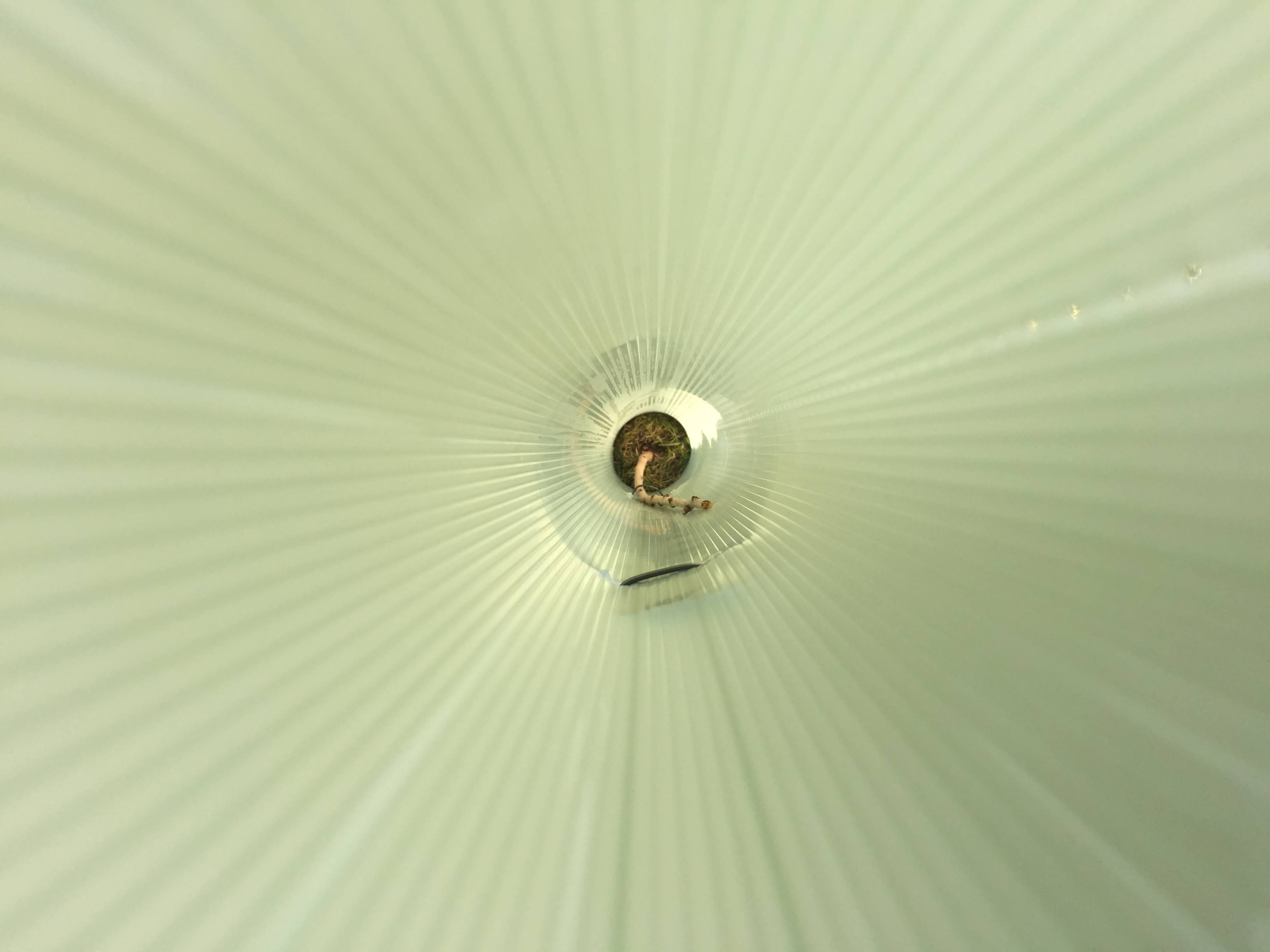
I think the next project for the farm is to plant some more fruit
trees and expand the orchard. There is an old goose garth which is
adjacent to the existing orchard, but has been used for sheep
grazing for many years. I'd like to plant apple trees, plum trees,
and maybe some cherry trees. We have a couple of cherry trees on
the farm, but they only produce a crop every few years. I imagine
this planting will be very different to the woodland planting. The
fruit trees will likely be larger when we buy them, and will
require more substantial guards as losing 1 of a total of 10 fruit
trees is more detrimental than losing 10 out of a total of 100
woodland trees.
In the next few years our main concern in the new woodland is going
to be keeping the grass mown around the trees, which without the
sheep to graze it will grow very fast. If we don't keep on top of
the grass it could overshadow the trees and affect their growth. It
could also cause the land to become shrubby thicket, which we don't
want.
The project was expensive, but most of this cost came from the tree
planting company, and the MOREWoods scheme helped enormously to
keep the cost of the trees down:
Item Cost (£)
---------- ----------
Fencing 2508.00
Trees 1584.00
Planting 5858.40
Observing how a professional tree-planting company organises
planting a woodland has given me a lot of confidence that if I
choose to do something like this again, I could easily make up for
the lack of expertise by having more volunteers and managing them
properly. I would have to spend a lot of time teaching to make sure
everybody knew how to plant a tree and make sure that the planting
area was marked out properly, but it would be worth it. It seems
like giving each person a small job, like laying out stakes in the
right place, or distributing trees to other volunteers is the best
way to make the job more efficient.